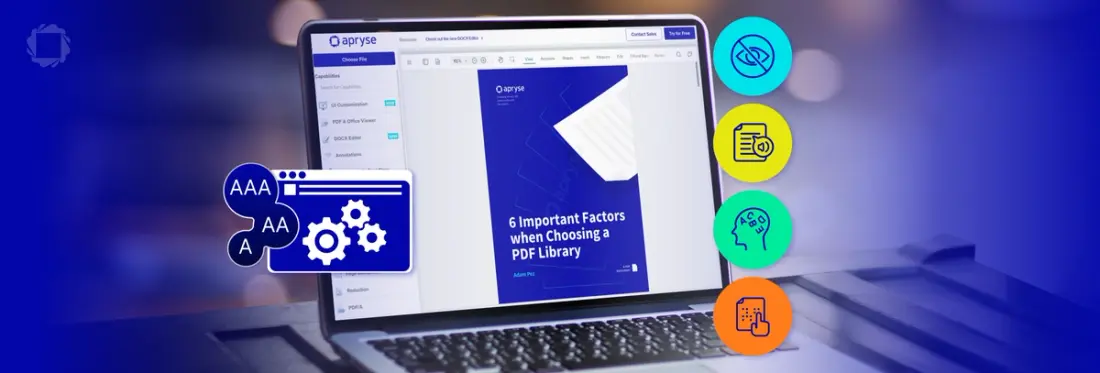Digital Transformation for All: How Web Accessibility Impacts DX Strategies
By Isaac Maw | 2025 Apr 30

5 min
Tags
PDF SDK
PDF accessibility
Summary: For developers, digital transformation and accessibility may seem like very different goals, but technologies such as Apryse SDK can help enable key improvements in both initiatives. With accessibility at the core, digital transformation can realize expanded reach, inclusive usability and improved adoption.
For many organizations, from businesses to public sector entities such as in healthcare, government, and education, digital transformation (DX) efforts have been in the works for decades. By continually adopting new technologies that make the organization more efficient and modern, organizations realize benefits that help them stay ahead of the game.
What Does Effective Digital Transformation Look Like?
All organizations are powered by processes, from intaking clients, to onboarding employees, to building things, taking payments, and supporting customers. Effective digital transformation is “digital first:” in other words, new tech isn’t shoehorned into old processes. Instead, digital ways of working replace old, outdated ways of working, ushering in new operational efficiency, improved experiences, and innovation.
This idea of “digital first” offers big promises, but it isn’t possible without accessibility. Processes can’t work if they aren’t usable by all the employees and customers who need them. That’s why accessibility should be viewed as a core tenet of digital transformation.
What is Web Accessibility?
According to the CDC, more than 28% of adults in the United States have some type of disability. Globally, an estimated 1.6 billion of us experience significant disability.
Since the advent of the internet, ensuring that the information and communication opportunities it provides are available to people experiencing disability has been important.
Not only does accessibility provide an inclusive experience for individuals with temporary and permanent disabilities, it also impacts the bottom line by avoiding legal consequences, by widening audience reach, and improving important aspects such as SEO ranking and helping to create a positive brand image.
In short, web tools that aren’t accessible fall behind those that are.
By integrating web accessibility into digital transformation efforts, organizations can reap double benefits by building workflows that are sustainable and competitive, even as regulations and business needs change.
“The power of the web is in its universality. Access by everyone regardless of disability is an essential aspect.” Tim Berners-Lee
Today, web accessibility compliance in many regions around the world is required. In most regions, including the US, Canada and Europe, regulations match up closely with the guidelines of WCAG 2.1 Level AA. Set by the World Wide Web Consortium, the WCAG guidelines ensure web content is accessible to individuals with vision, hearing, cognition, and other impairments. For example, the guidelines require non-text content, such as images, to provide text alternatives.
When your web product meets WCAG guidelines, it’s not only an intangible benefit for inclusivity. It also has bottom-line implications: accessibility compliance can make a product to a wider set of customers, and avoid steep monetary penalties.
Accessibility-Centric Digital Transformation
Digital first processes improve user experience, and enable other benefits such as data-driven insights, automation and efficiency. People often think of end-user experience as relating to customers, but employees are end users too, and improved experiences for employees help your teams work faster and with fewer mistakes. Accessibility is an important part of user experience. For example, PDF document tagging is essential for supporting assistive technology such as screen readers, but it also makes PDF documents machine-readable, compliant, and ready for scalable automation.
Digital transformation is an ongoing journey, but you can help future-proof your investments by making accessibility part of your design culture. Considering accessibility when choosing vendors can help avoid future efforts to align with WCAG guidelines.
For example, choosing Apryse WebViewer ensures that your document UX is accessible, with updates delivered by Apryse to maintain compliance into the future.
Apryse SDK for Accessible DX
Or document processing solutions are designed to help developers deliver new, digital document workflows for greater efficiency, security and ease of use. In addition, we’re committed to accessibility, with WCAG 2.1 Level AA compliance built into our Web SDK, ensuring that document experiences using our SDK are accessible.
Learn more about capabilities and accessibility on our website.
Partnering with a provider that offers a broad portfolio and commitment to innovation helps businesses stay ahead. Digital transformation is complex and varies across organizations. Adopting a phased approach allows businesses to address specific needs and stay aligned with their goals.
Examples of Accessibility-Centric Digital Transformation
In healthcare, patient records are a major focus area for digital transformation. For example, many healthcare organizations have adopted digital-first portals for electronic health records. Without accessibility compliance, these EHR portals wouldn’t meet compliance standards for the healthcare industry, and many end users would face challenges accessing the documents.
In web content, experiences such as knowledge base content and documentation may require PDF viewer tools, and built-in accessibility features in the PDF viewer UI can help the entire website meet WCAG guidelines, boosting SEO and improving reach.
Best Practices for Accessible Digital Transformation
Because both accessibility compliance and digital transformation are ongoing journeys, the following best practices can help with both objectives.
- Understand your accessibility needs, including regulations and internal standards.
- Ensure your vendors are aligned with your accessibility focus and are committed to keeping up with your needs.
Conclusion
Accessibility and digital transformation are both ongoing improvement projects that require a phased approach. When choosing technology partners, focus on industry expertise, seamless integration, scalability, security, and ROI. An ongoing commitment to accessibility-centric design requires a cultural shift, valuing the benefits of accessibility at all levels of development. Choosing vendors that uphold these values can help your teams stay the course.
If you’re ready to prioritize accessible development, reach out to our team.
Tags
PDF SDK
PDF accessibility

Isaac Maw
Technical Content Creator
Share this post


